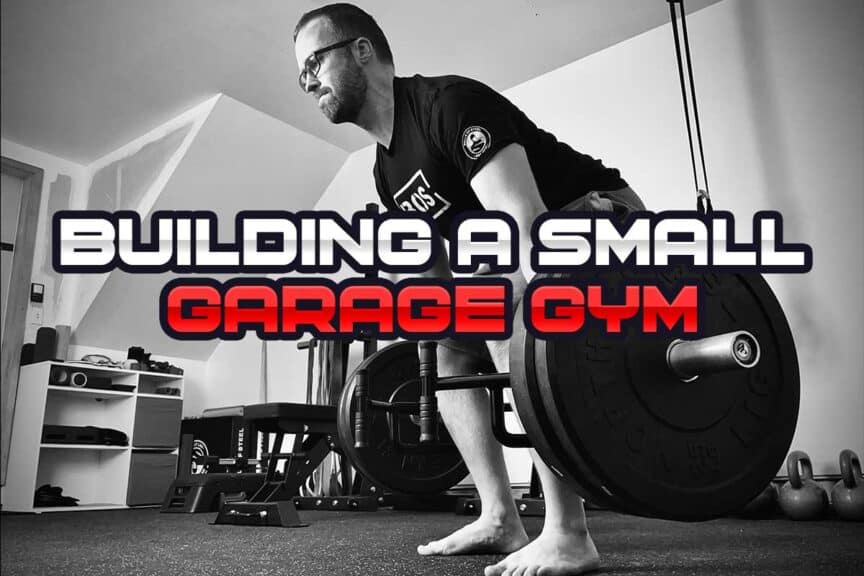Building a garage gym is one of those processes that can be super exciting but a bit overwhelming; there are so many factors to consider, and creating the most optimal space can feel like a challenge if space and budget are limited. But don’t let that turn you off from building the garage gym of your dreams! If you’re smart with your approach, building a practical, space-efficient setup can be a rather straightforward process!
I’m so stoked to help guide you through this! So, let’s get right into it with some quick bullet points!
To build a home gym in a small garage, you’ll want to:
- Consider the type of training you want to do
- Be mindful of any additional usage needs for your garage
- Consider the most ideal layout
- Select versatile and movable equipment
- Implement optimal storage solutions
- Give your space some character!
There are plenty of valuable nuggets and pearls of wisdom to unpack within each of those bulleted points, mind you, which I’ll get into below. Nonetheless, I wanted to give you a brief overview of how to build an effective garage gym that will meet your needs, regardless of the size restraints you may be under.
Ever since I moved into my new place a few months ago, I’ve been slowly building up my own garage gym. Like many other folks, it’s a smaller gym, and I’m on a tight budget. As such, my garage gym is far from complete. But I’ve been involved with gyms for enough years that I know how to tackle this sort of issue. So, if you want some practical insight and hidden gems within this insight, keep on reading!
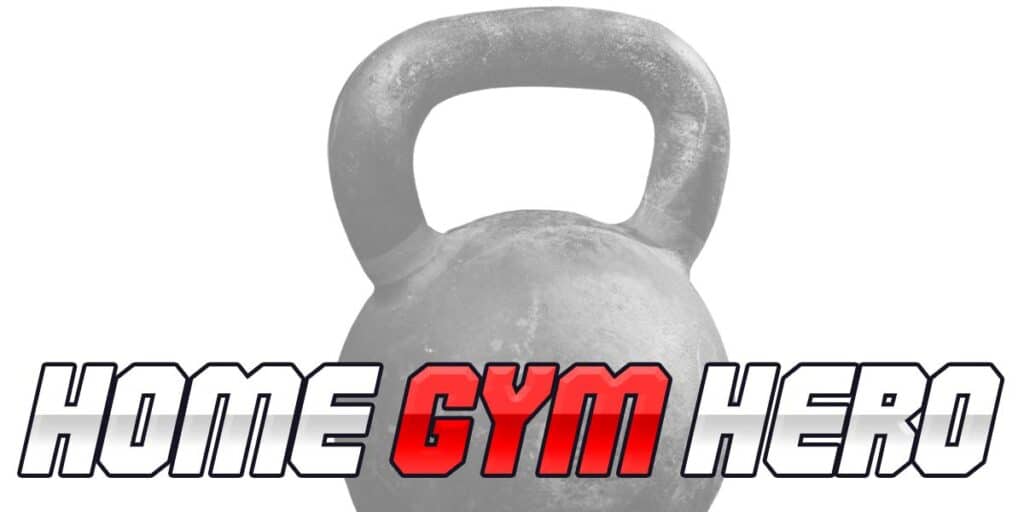
A small request: If you find this article to be helpful, or you appreciate any of the content on my site, please consider sharing it on social media and with your friends to help spread the word—it’s truly appreciated!
Tip 1: Know what type of training you want to do
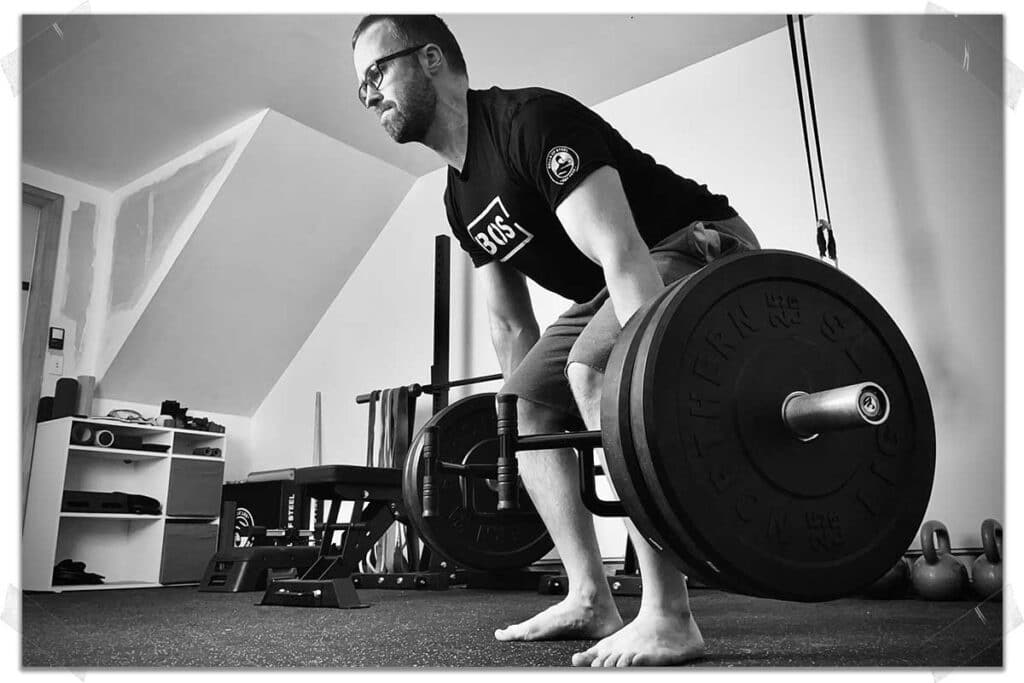
It might sound silly, but this is where we need to start. The truth of the matter is that the type of physical training you want to do can vastly influence how you construct and layout your floor space within your garage.
Knowing what type of exercise or training you’ll want to do in your rather small garage space will help you to:
- Know which type of equipment may be best (both for your space and your budget);
- How you’ll need to layout your available floor space to accommodate your training and exercise needs.
As an example, if you’re looking to perform HIIT (High-Intensity Interval Training), chances are high that you’ll need a designated open area in which you can perform various full-body movements. If, on the other hand, you want to perform traditional bodybuilding exercises (biceps curls, pushups, dumbbell squats, etc.), chances are you can get away with having less open floor space than someone wanting to perform various full-body exercises that involve hopping, shuffling, etc.
Pro tip: Your available space might be small enough that you might not have much of a say in how you lay out your exercise area for the type of training you want to do. Don’t sweat it; just do what you can. Something is better than nothing.
Once you know what type of fitness activities you want to use your garage space for, you’ll need to consider and implement the next tip!
Tip 2: Take into account any other uses of your garage
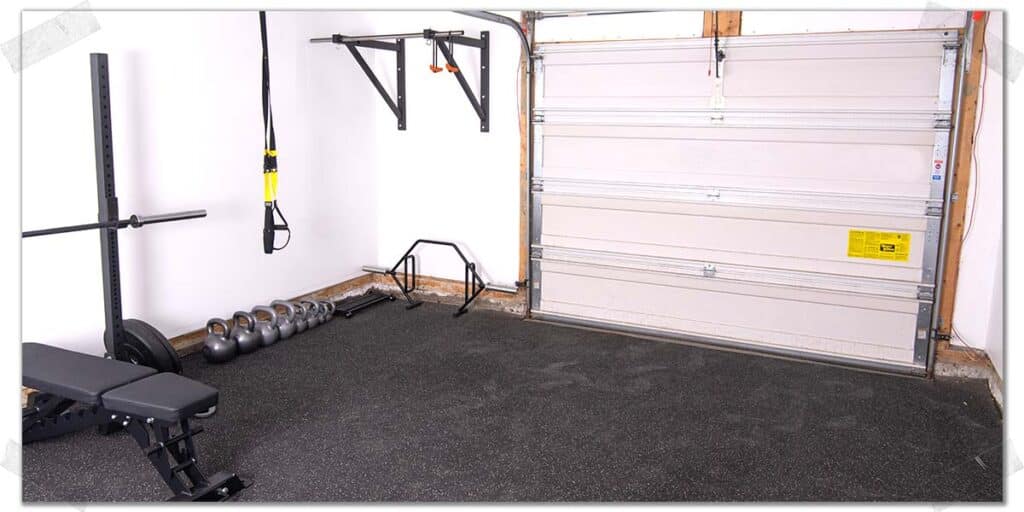
In a perfect world, you and I would have one garage for training and another separate garage (or, at least, a large enough garage altogether) for more traditional garage uses. You know, for stuff like…parking your vehicle within it.
As I’m sure you’re aware, the overarching challenge with this whole scenario is that a small garage typically doesn’t simultaneously allow for fitness equipment usage and vehicle storage. Additionally, you might want or need to use your garage space for other activities (fixing things, building things, storing non-fitness-related equipment, etc.).
As such, before you start to construct an area to exercise in your garage, it would be prudent of you to consider what else you might need to use your space for. After all, there’s likely nothing worse than building the gym setup of your dreams only to realize you didn’t account for the additional ways you’ll need to use your garage.
Related article: Building Your Home Gym On A Budget (Get Stronger For A LOT Less)
So, before you start taking action and diving into gathering your fitness equipment, take a step back and ask yourself if there are other ways or times in which your garage may need to be used for other activities besides working out and exercising.
Even if you don’t plan on using your small space for any other activities, take a bit of time to imagine any unforeseen scenarios where it would be beneficial to have some extra space to use.
A bit of extra planning can not only go a long way in ensuring you have available space for additional activities, but it can also for saving you a world of frustration from designing the perfect small gym space to thereafter having to reconstruct it due to a lack of planning for other needs.
Tip 3: Consider the most ideal equipment layout for your floor space

With the first two tips taken care of, now it’s starting to get fun! This is the part where you get to visualize how you might want to lay out the contents of your garage gym.
Take some time with this process. While you can always change the layout, having to move any heavy or bulky equipment isn’t fun to do, so thoroughly thinking things through before getting your equipment set up and laid out can save your time and your back!
Fun fact: I’m still considering re-arranging a few pieces of equipment in my home garage gym even after having my basic equipment set up for well over six months now!
Of course, depending on the available floor size you have to work with, you might feel like you don’t have much of a say in where things go. Just do what you can. Even having one or two pieces of smaller equipment that you can place wherever you feel best is a good feeling.
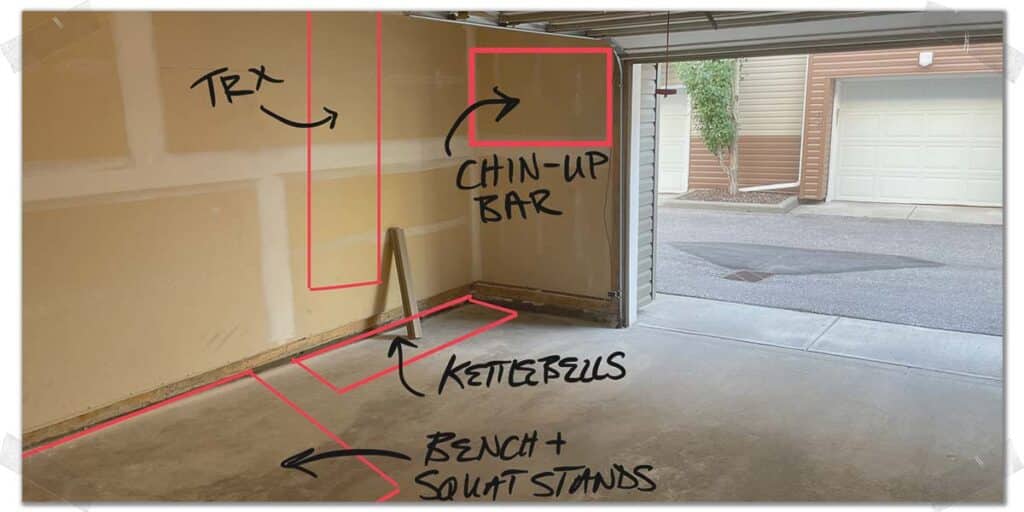
Here are some of my additional insights with this:
- Come up with a couple of different layouts to consider, if possible. Each potential layout might have its unique advantages.
- Try to lay out your equipment in a way that not only maximizes your available space but optimizes your training flow as well.
- Your layout may be influenced by tip 2 of this article (consider other uses you’ll need your garage for).
- You’re not buying a house here; if you don’t like your layout, you can always change it up. So, don’t sweat it if you need to try one or two different configurations before settling on the right one for you.
Tip 4: Stay as modular as possible with your home gym equipment
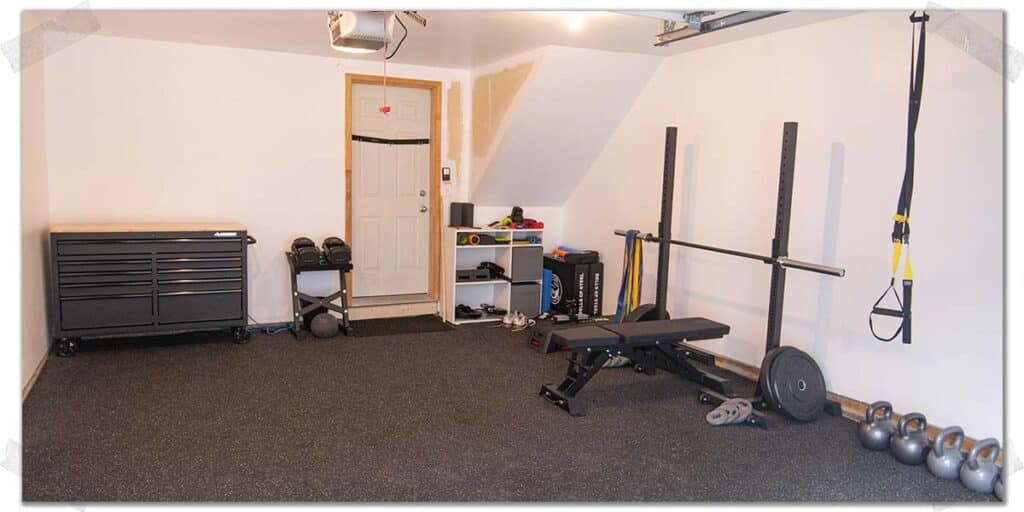
If you plan on using your garage space for anything else other than working out, it’s worth using exercise equipment that is portable or movable within your garage.
As an example: While I don’t park my vehicle in my garage, I’ve always kept in mind that I might need to at some point (either expectedly or unexpectedly). As a result, I’ve made sure that any fitness equipment or storage units within my garage can be moved around in a manner that would afford me the space to pull my vehicle in if need be.
Here are some of the ways I’ve ensured my garage gym setup stays as modular as possible:
- I use a Husky workbench (purchased at The Home Depot) for storage (more on that shortly) that is on wheels, allowing it to be moved freely and effortlessly within my garage when needed.
- I use a set of PowerBlocks as my dumbbells. Rather than having to move an entire rack of dumbbells, I can easily move my two PowerBlocks and their little stand out of the way within under one minute.
- Instead of using a squat rack or cage (which is also less space-efficient for me), I use a set of squat stands for any squatting and bench press exercises I perform. Squat stands are sturdy enough for my lifting needs and can easily be moved or wheeled out of the way when needed.
Tip 5: Pick versatile exercise equipment (a bigger bang for your buck)
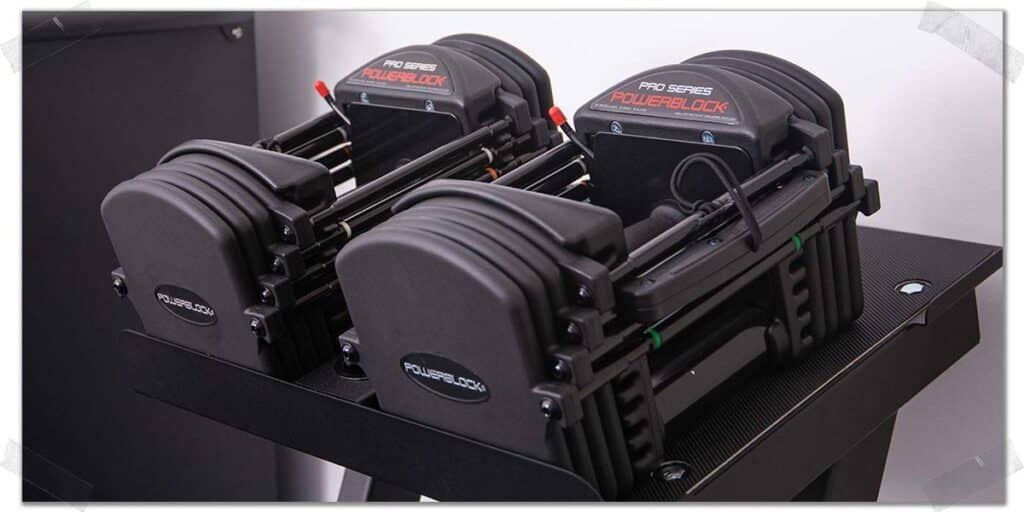
If you’re anything like me, you not only have limited garage space to workout with, but you also have a budget to stay within. When you’re up against these two very common factors, you need to be very wise with the equipment you bring into your garage.
Selecting exercise equipment that is versatile will not only save you plenty of space, but will also afford you greater training variety, meaning you can do more training with less equipment, saving you plenty of money.
Now, to be clear, the type of equipment you select is highly dependent upon the type of training you want to do. Assuming you’re interested in performing traditional strength training exercises (exercises commonly performed by athletes, bodybuilders, powerlifters, etc.), here is a list of equipment that is highly versatile, practical, and economical that I would consider investing in:
Equipment piece 1: A TRX suspension trainer

This would be top of my list. There’s nothing that beats this piece of fitness equipment for the versatility it provides compared to its cost. Not to mention, it takes up hardly any space and can be mounted to the wall, a ceiling, or even used in a door.
Equipment piece 2: A set of adjustable dumbbells
While some brands can cost a pretty penny, the investment is well worth it when considering the world of strength training exercises they provide while taking up hardly any space. I personally use PowerBlocks since they’ve been around the longest, have an industry-leading reputation and have no moving parts. These things should last for as long as I need them.
Equipment piece 3: A few pairs of kettlebells.
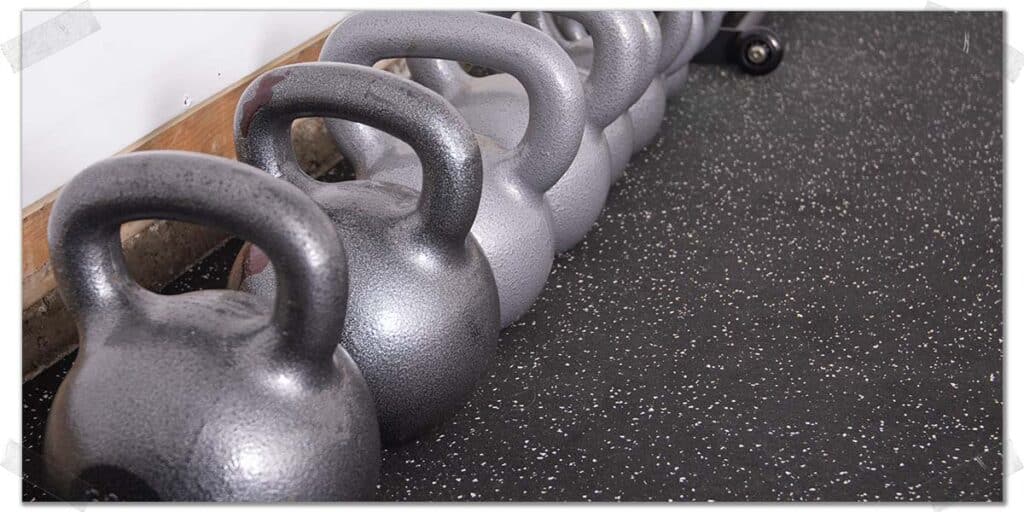
The beautiful thing about kettlebells is that they open up an entirely new world of exercises, take up very little space, and will last you a lifetime (they’re just pieces of iron, after all). No need to pick out an entire set. With nothing more than a pair of light, and medium-weight kettlebells, you’ll have plenty to keep you moving and sweating. You can always pick up a pair of heavy kettlebells down the road if your training requires so and when your budget allows it.
Equipment piece 4: A workout bench
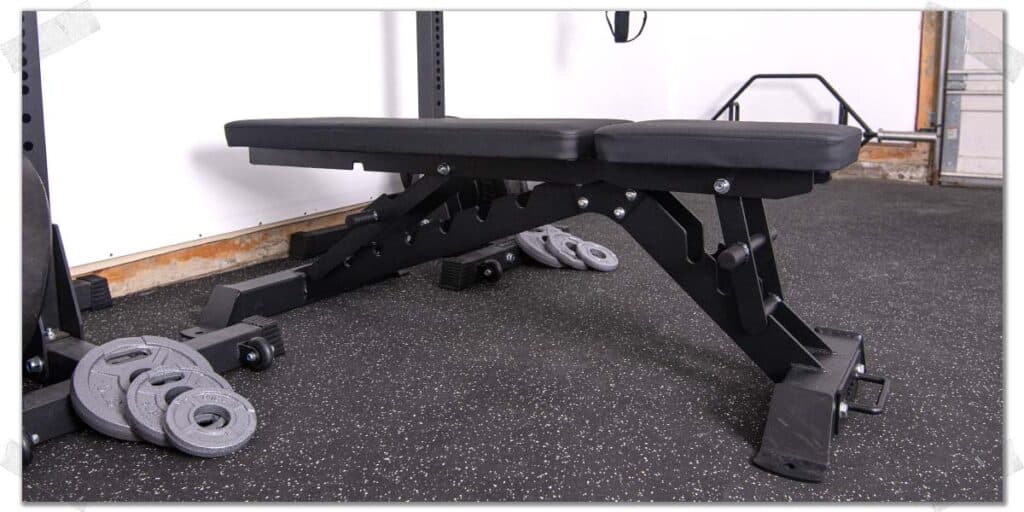
A workout bench—it will come in handy for more than just lying on. While these things can cost a surprising bit of money, the good news is that unless you plan on doing some heavy-duty powerlifting or weightlifting, you likely don’t need anything top-of-the-line; a basic bench should do just fine. I use the Bells of Steel Buzzsaw bench (affiliate link)—the thing is built like a tank, and while you might not need anything this robust, if you want a heavy-duty adjustable workout bench, I’d personally recommend this one.
Equipment piece 5: A set of squat stands
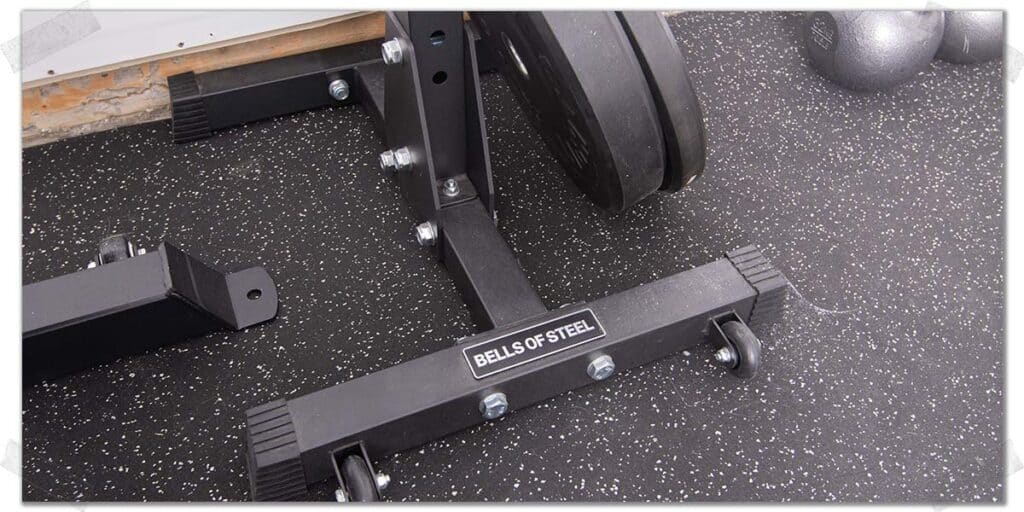
If you’re interested in barbell squatting and bench pressing, you’re going to need some equipment to rack the bar upon. For a small home gym, squat stands are the way to go; they’ll save you an immense amount of space, money, and time if you need to constantly move or rearrange your equipment. I use squat stands made by Bells of Steel (affiliate link). Would I love to have an actual squat rack? Of course, but it’s not in the cards for me, so these squat stands do the trick instead!
Equipment piece 6: A chin-up or pull-up bar
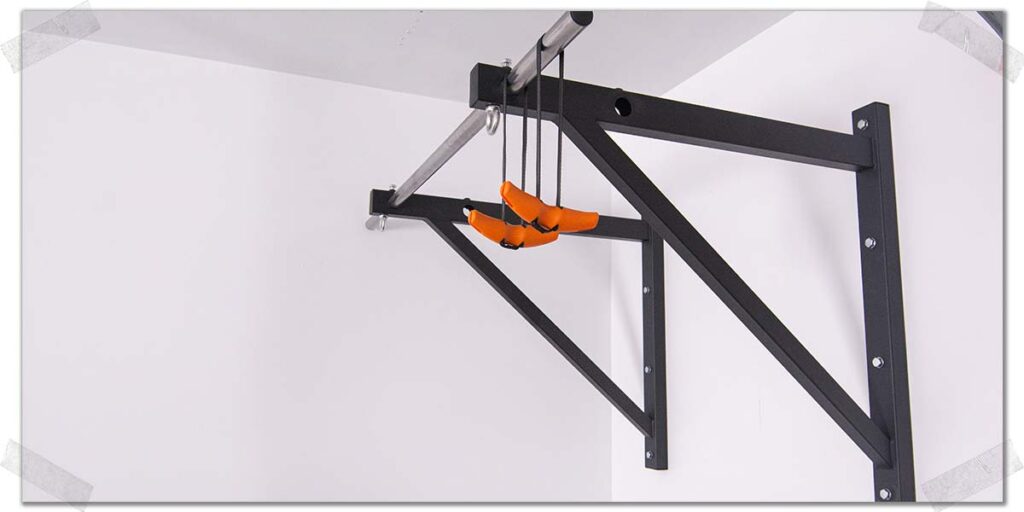
While this battle-tested, age-old piece of equipment can’t be easily moved around within your garage (unlike the pieces of equipment mentioned above), it provides a world of outstanding strength exercises for those who are serious about upper body strength training. Just bolt it into the studs within your wall, and you’ll be good to go for numerous pulling-based exercises.
Tip 6: Be smart with your garage storage solutions
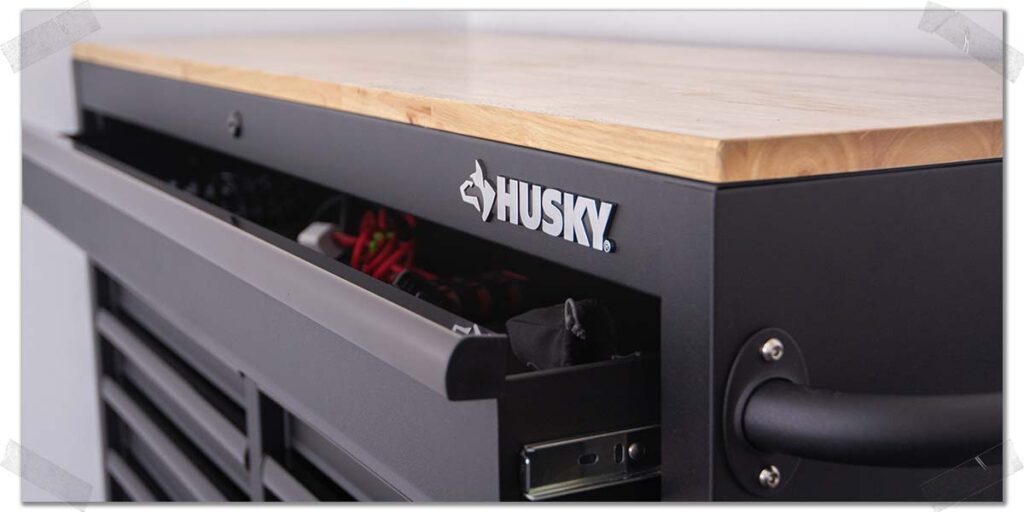
To get the most out of your training space, you will need to be smart with storage – for both fitness and non-fitness equipment. After all, plenty of people with garage gyms need to store more than just fitness equipment in their space.
Even a large garage can fill up at a quick rate. And since you and I have an overall smaller garage (and perhaps budget) to work with, we need to be extra economical with how we organize and store everything within it.
The ideal storage solutions for you will depend on the size of your garage and budget and the contents you’re trying to store and organize.
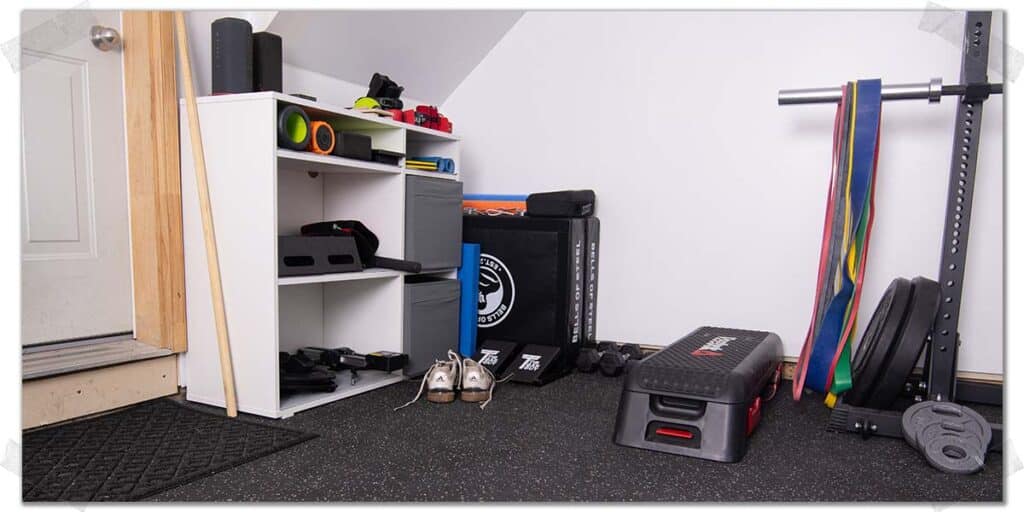
Here are my recommendations for storage considerations for your workout area:
- A mobile workbench can be a solid investment for your space, particularly if you also have plenty of tools or non-fitness-related items that need to be stored and organized. The bonus here is that you’ll also have a desktop that you use for additional work tasks or storage options.
- A simple IKEA shelf or similar storage shelf can go a long way. I have an IKEA Vihals shelving unit. The Kallax shelving unit can also be a practical choice for those needing some nice-looking (but affordable) storage solutions.
- Overhead storage solutions can be a fantastic solution for plenty of home gyms. They can cost a bit of money but can be well worth it. I’d say these solutions are best for non-training equipment belongings since accessing them can be a bit of a hassle once they’re tucked away overhead. While I currently don’t have any overhead storage in my home garage, there may come a time when this changes.
Tip 7: Give your garage gym some character (make it your own)
This is easily the most enjoyable part of building a workout space or a gym. This is your space, and it should reflect as such!
My personal recommendations for decorating your home gym are:
- Fill your walls (or even the ceiling) with contents (photos, posters, flags, etc.) that motivate you or inspire you. Whether it’s images of others that you find favor in, or quotes and phrases that give you energy, if it gives you positive vibes, get it up on your walls!
- Keep your decorations authentic; if it doesn’t truly align with your values or personality, it’s not worth it. It doesn’t matter what others say – this is your space, not theirs!
Remember, this is your space, so anything goes! And, of course, there’s nothing wrong with keeping your decorations on the minimal side if that’s what you’d prefer. This is your home workout facility, not mine!
Fun fact: The bonus of having a smaller gym space means it’s much easier to deck out the entire space to your liking; you won’t spend as much money or time to complete this task as you would a larger garage gym!
Final thoughts
Alright, so now that you know what it takes to build a small but totally brilliant garage training space, go put your thinking cap on and start working on how you’re going to build the small garage gym of your dreams!
Also, if you want, feel free to tag me on Instagram with any photos of your home gym setup that you’d like to share—I would absolutely love to see them!
Frequently Asked Questions
I like to make my articles as helpful as possible, which is why I’ve started including brief answers to some commonly asked questions within each post. Below, you will find a couple of brief answers to questions that often arise on the topic of constructing and working out within a small home gym.

Hi! I’m Jim Wittstrom, PT, DPT, CSCS, Pn1.
I am a physical therapist who is passionate about all things pertaining to strength & conditioning, human movement, injury prevention and rehabilitation. I created StrengthResurgence.com in order to help others become stronger and healthier. I also love helping aspiring students and therapists fulfill their dreams of becoming successful in school and within their clinical PT practice. Thanks for checking out my site!

